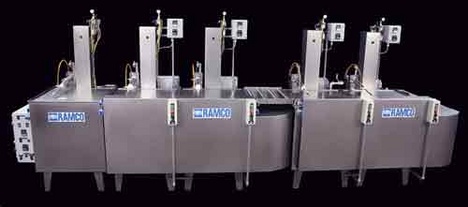PASSIVATION USING NITRIC ACID AND CITRIC ACID

Stainless steel derives its corrosion-resistant properties from its chromium content. Chromium, in the presence of oxygen, forms a thin, hard, adherent film of chromium oxide on the surface of the alloy. It is this chromic oxide layer, inert (passive) to the surrounding environment, which gives stainless steel its corrosion-resistant properties. Manufacturers in numerous sectors use passivation to create this protective oxide layer.
At Advanced Deburring & Finishing, we provide industry professionals with the most advanced nitric acid and citric acid passivation equipment. Let’s take a closer look at what passivation is, why it’s important and how it works.
What Is Passivation?
Passivation, according to ASTM A380, is:
“The removal of exogenous iron or iron compounds from the surface of stainless steel by means of a chemical dissolution, most typically by a treatment with an acid solution that will remove the surface contamination, but will not significantly affect the stainless steel with a mild oxidant, such as a nitric acid solution, for the purpose of enhancing the spontaneous formation of the protective passive film.”
Simply stated, utilizing a mild oxidant, such as a mineral or organic acid solution, to promote the removal of excess iron from the surface of the stainless steel, will enhance the formation of a chromic oxide layer, thereby enhancing its corrosion-resistant properties.
Why Use Passivation?
Passivation is an essential process for making stainless steel rust-resistant. The process has been a best practice for steel production since the 1900s because of its ability to:
- Create a chemical barrier against rust.
- Extend the steel’s life span.
- Remove harmful contaminants from a piece’s surface.
How Does Passivation Work?
As an iron-based alloy, stainless steel consists of iron, chromium and nickel. The corrosion-resistant properties of stainless steel come from its chromium content. When exposed to oxygen, the chromium transforms into a layer of chromium oxide that protects the steel from rust.
Passivation works by immersing stainless steel parts into an acid bath that dissolves the surface’s iron particles while maintaining the chromium content. Removing the iron with acid allows the steel to develop a surface higher in chromium than the underlying steel.
Once you remove the stainless steel from its acid bath, oxygen reacts to the chromium-rich surface and forms a thick layer of protective chromium oxide. This thicker layer drastically reduces the risk of corrosion and extends the part’s life span.
The Passivation Process
Typically, passivation is performed with a nitric acid bath from 20 to 50% by volume. Temperatures range from ambient to 160 degrees F. Immersion times can be as long as two hours and even include the addition of chromate salt.
Nitric acid is by far the most accepted means by which passivation is performed. Recently, however, there has been an increase in the number and type of industries that have successfully implemented citric acid into their passivation procedures.
There are numerous passivation processes, and each one varies based on the type and grade of the metal you’re working with. Despite these differences, nearly all of the procedures follow the same three stages, including:
- Clean the parts: You’ll first use passivation pretreatment systems to clean the metal and remove any dirt, oil or grease from the surface.
- Passivate the metal: Once the parts are clean, you can perform the passivation by running them through a citric acid or nitric acid bath.
- Test for effectiveness: Finally, you’ll test the effectiveness of the passivation process to ensure a thick enough passivation layer formed on the metal.
The chromium oxide layer typically forms over 24 to 48 hours when working with nitric acid. Some manufacturers add sodium dichromate to the nitric acid bath to speed up the process, but as this is a toxic compound, it requires specialized knowledge for use.
How to Ensure Passivation Is Successful
Passivation is a proven process that’s easy to navigate, but you should take some essential steps to ensure you corrode the free iron in a controlled and uniform manner. To succeed in passivation every time, you should:
- Maintain a clean acid bath: Keep your acid bath free of contaminants.
- Follow best pretreatment practices: Pretreating your parts by cleaning them thoroughly is an essential part of keeping your acid bath clean and effective.
- Only work with one grade of steel: Putting two different grades of steel in the acid bath at the same time will corrode one type faster than the other.
Choose Advanced Deburring & Finishing for Your Passivation Equipment
At Advanced Deburring & Finishing, we have almost 40 years of experience providing our customers with the most advanced finishing and cleaning technology. Our team is dedicated to helping your business achieve higher-quality results, lower production costs and improved efficiency.
Get in touch with us online to learn more about our passivation systems and components, or call a member of our team at 717-764-1056.